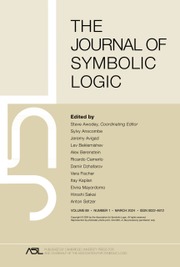No CrossRef data available.
Article contents
ON THE CATEGORICITY OF COMPLETE SECOND-ORDER THEORIES
Published online by Cambridge University Press: 27 August 2025
Abstract
We show, assuming PD, that every complete finitely axiomatized second-order theory with a countable model is categorical, but that there is, assuming again PD, a complete recursively axiomatized second-order theory with a countable model which is non-categorical. We show that the existence of even very large (e.g., supercompact) cardinals does not imply the categoricity of all finitely axiomatizable complete second-order theories. More exactly, we show that a non-categorical complete finitely axiomatized second-order theory can always be obtained by (set) forcing. We also show that the categoricity of all finite complete second-order theories with a model of a certain singular cardinality  $\kappa $ of uncountable cofinality can be forced over any model of set theory. Previously, Solovay had proved, assuming
$\kappa $ of uncountable cofinality can be forced over any model of set theory. Previously, Solovay had proved, assuming  $V=L$, that every complete finitely axiomatized second-order theory (with or without a countable model) is categorical, and that in a generic extension of L there is a complete finitely axiomatized second-order theory with a countable model which is non-categorical.
$V=L$, that every complete finitely axiomatized second-order theory (with or without a countable model) is categorical, and that in a generic extension of L there is a complete finitely axiomatized second-order theory with a countable model which is non-categorical.
Information
- Type
- Article
- Information
- Copyright
- © The Author(s), 2025. Published by Cambridge University Press on behalf of The Association for Symbolic Logic


